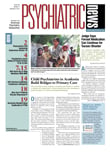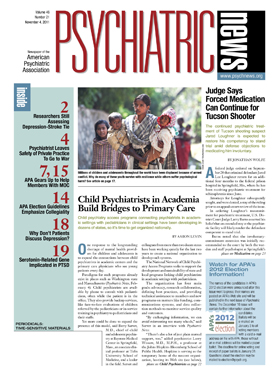One of APA's many accomplishments of which I am extremely proud is our set of increasingly evidence-based practice guidelines. Under the strong and long leadership of Jack McIntyre and Sara Charles (and now under the new leadership of Joel Yager), plus the hard work of the Steering Committee on Practice Guidelines and many teams of experts, APA has developed a set of guidelines that have become standard reference documents used nationally and internationally.
I recall the days when the idea of developing practice guidelines was first discussed, an idea that was not free of controversy. Many feared that it would encourage "cookbook medicine" (a sentiment also expressed by some about the criteria-based system of DSM-III). At the time (the late 1980s and early 90s), the field was transitioning from a long tradition when clinical expertise and theory guided our treatment recommendations to a more evidence-based approach. A two-day conference was held in Washington, D.C., in 1992, titled "Challenges in Developing Psychiatric Practice Guidelines," cochaired by Jack McIntyre and me. I chaired the second day of the conference, which was dedicated to what we thought of at the time as "Track II" conditions—those that were prevalent in clinical treatment populations, but about which there was little published research. We called the second day of the conference "New Methods in Guideline Development: What to Do When the Database Is Incomplete," and the "poster" example I presented was borderline personality disorder (BPD). We were wrestling with how to establish a standardized process to develop treatment recommendations based largely on a consensus of clinical experts, in cases where research was still in its early stages.
It turned out that it took almost a decade to get back to BPD, and when we explored the feasibility of using our standard evidence-based template, a substantial amount of research had been published on BPD, so we did not need a separate procedure. But from early on, the APA guideline-development process advised that the evidence base for practice guidelines should come from both research studies and clinical consensus, and how to standardize the process of incorporating clinical expertise and opinion into our guidelines remained challenging.
In 2009 Jack McIntyre "termed out" as head of the steering committee, and with great appreciation for Jack's many years of leadership, we were fortunate that Joel Yager agreed to step up to the plate. This transition in leadership seemed a good time to take stock and review our overall practice-guideline strategy, in the context of growing national attention to evidence-based medicine. The steering committee monitored several emerging standards, particularly from the Institute of Medicine and the AMA Physicians Consortium for Performance Improvement, and proposed a new process for the development of APA practice guidelines, one that is both structured and transparent. This proposal was widely distributed and revised based on extensive feedback. I think it represents a state-of-the-art new template that will ensure that we identify pertinent new research findings while engaging the participation of carefully selected experts. Let me elaborate a bit on three components of this new process: PICO questions, the GRADE system, and the process for determining expert consensus.
PICO questions are increasingly utilized throughout medicine as a method to organize guideline development. PICO stands for Patient, Population, or Problem; Intervention; Comparison; and Outcome. After a new topic is selected for a practice guideline by the steering committee, the Guideline Writing Group, with input from staff, consultants, and the steering committee, will develop approximately 10 "PICO questions" that will be distributed for feedback and around which guideline recommendations will be framed. The polished PICO questions will form the basis of literature reviews performed by a separate Systematic Review Group. Based on the results of these reviews, the Guideline Writing Group will identify potential recommended interventions.
The GRADE system is a standard method to rate quality of evidence and the strength of resulting recommendations. With various modifications, this system is used by many organizations, including the Agency for Healthcare Research and Quality, the American College of Physicians, and the World Health Organization. GRADE stands for Grading of Recommendation, Assessment, Development, and Evaluation. The quality of a body of evidence is rated "high quality," "moderate quality," or "low quality," and the strength of a recommendation based on this evidence may be rated either "strong" or "weak."
The new guideline development process also includes a new process for determining expert consensus. Research experts on a topic will be nominated by chairs of academic departments, as well as by current and past practice guideline work groups and officers of pertinent subspecialty organizations. In parallel, chairs of academic departments, directors of psychiatry residency training programs, and the APA Assembly will nominate clinical experts on the same topic. From these two pools of recommended experts, expert consensus panels will be formed. These panels will be asked to review evidence summaries and to provide opinions, via formal surveys, regarding the proposed recommendations and related issues.
I believe that these new procedures will sustain our commitment, long stated in our guideline process, that the evidence base for practice guidelines comes from both research studies and clinical consensus, but with a new formal process for input from the APA Assembly and from academic psychiatry.
In March, the Institute of Medicine finalized and issued two sets of standards: Standards for Systematic Reviews and Standards for Trustworthy Guidelines. Our proposed new procedure has already incorporated many of these IOM standards, and the steering committee is evaluating them carefully to align our new process to these standards, where appropriate. Under the steady leadership of Joel Yager, the APA practice guideline process is rebooting itself to be at the forefront of evidence-based medicine.


